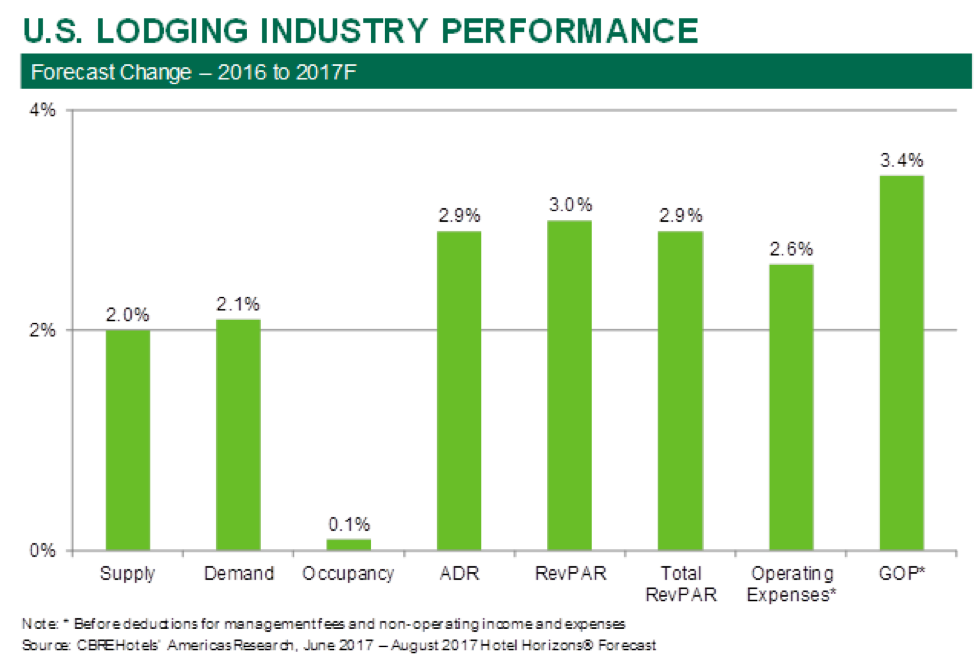Atlanta – May 23, 2017 – The U.S. lodging industry started 2017 on a strong note. During the first quarter of 2017, hotel demand increased by 2.8 percent. The result was an occupancy of 61.1 percent, the highest first quarter occupancy rate reported by STR in the past 30 years.
“Since bottoming out in the fourth quarter of 2009, U.S. lodging demand now has grown for 29 consecutive quarters, and led to the record occupancy levels we currently are observing,” said R. Mark Woodworth, senior managing director of CBRE Hotels’ Americas Research (CBRE). “We realize that favorable prior year comparisons contributed to the strong growth in first quarter demand, and that pace cannot be sustained through the rest of 2017. However, given the positive economic outlook for the remainder of the year, we are projecting demand to outpace supply once again in 2017, thus resulting in an eighth successive year of occupancy growth for the U.S. lodging industry.”
According to the recently released June 2017 edition of Hotel Horizons®, the supply of available rooms in the U.S. is projected to increase by 2.0 percent during 2017 following a 2016 gain of 1.6 percent per STR. Concurrently, lodging demand is forecast to rise by 2.1 percent. The net result is an increase in occupancy from 65.4 percent in 2016 to a third consecutive annual record occupancy level of 65.5 percent in 2017.
Room to Grow
“We are in a period of record annual and quarterly occupancy levels. Accordingly, we need to look at specific days of the week, seasons of the year, and markets with new supply to identify when and where new lodging demand can be accommodated,” Woodworth stated. “These factors help to guide and explain our forecasts.”
From 1988 through 2016, the highest U.S. hotel occupancy levels on average have been achieved during the third quarter. This trend continues in 2017 when CBRE is forecasting an occupancy rate of 70.7 percent from July through September. “Because of realistic capacity constraints, third quarter demand growth will be limited to 1.3 percent. Hoteliers should not misinterpret this relatively low level of demand growth and distort our positive outlook for travel this summer,” Woodworth said.
While seasonal patterns have been consistent over the years, there has been a shift in lodging performance by day of the week. Per STR, occupancy and ADR levels have grown greater on the weekends versus weekdays since 2000. In fact, U.S. hoteliers are now able to charge higher room rates on Friday and Saturday nights compared to the other days of the week.
“In 2016, weekend occupancy averaged 71.3 percent, while weekday occupancy was 62.3 percent. This indicates that there is room to accommodate new corporate and group demand, and the outlook for the economic indicators that drive these market segments is quite positive for the next few years,” Woodworth noted.
Downtown
CBRE Hotels’ Americas Research not only prepares forecasts for the six U.S. chain-scales, but for six U.S. location categories, as well. When assessing CBRE’s forecasts of performance by location category, the robust amount of development activity occurring in urban areas becomes evident.
“To paraphrase Billy Joel, it’s an uptown world for hotel development,” said John B. (Jack) Corgel, Ph.D., professor of real estate at the Cornell University School of Hotel Administration and senior advisor to CBRE Hotels’ Americas Research. “Developers have been leaping over historical hurdles and getting deals done in the urban core of the nation’s major markets.” For 2017, CBRE is forecasting the nation’s urban areas to experience a 3.4 percent increase in their lodging stock.
“In our lodging forecasts, it is important to note that we project accommodated demand. Urban developers have tapped into the preferences of today’s travelers by building moderate-priced and select-service properties in these urban areas. Accordingly, our forecasts of 3.3 percent demand growth in urban markets almost matches the 3.4 percent increase in supply,” said Corgel. For 2017, CBRE is projecting urban hotel occupancy to be 73.0 percent, which ties airport areas for the greatest occupancy level among the six location categories.
Still Strong
“After so many quarters and years of record breaking performance, plus all the new supply, labor and geo-political challenges, it is not surprising that industry participants are leery regarding the future of the U.S. lodging industry. However, when you take a hard look at the data and scrutinize issues like seasonality, locational variances and weekday/weekend demand patterns, you can see where there still is some upside potential,” Woodworth concluded.




